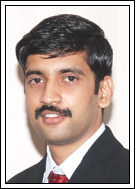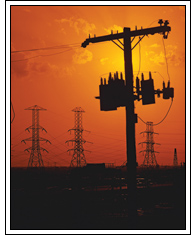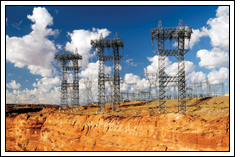
Today’s power grid faces several technical challenges. For instance, electrical energy is not typically stored in significant quantities, making it difficult for operators to manage the peaks and troughs in supply and demand.
It is difficult to identify any aspect of our lives that has not been transformed by technology. Whether it is the smart phone in our pocket, the way we read books or the wealth of knowledge the Internet brings to our fingertips, the world is transforming before our eyes. Entire industries are being “digitised”, where software, networks, processors and sensors fuse together to exchange information and help solve problems.
In contrast, the way we generate, transmit and distribute electrical power is still firmly rooted in analogue technologies, developed before the modern computer and Internet era. The grid faces a great number of technical challenges. For example, electrical energy is not typically stored in significant quantities, making it difficult for operators to manage the peaks and troughs in supply and demand, whether it is for air conditioning in the excruciating summers or switching the geyser on during the freezing winters! To make matters worse, as smart phones, tablets, electric vehicles grow in popularity, this peak demand will increase yet further to provide the power necessary to charge them. Patterns of demand are changing, but so is generation. The latest renewable energy sources, such as wind, solar and wave (tidal) energy, are inherently variable in production and significantly more distributed geographically, even down to individual domestic properties.
Facing these challenges will require new types of energy storage and much more sophisticated, distributed control, but the first step towards implementing a “Smart Grid” is to create true situational awareness. This means we can know not just the flow and balance of power, but can also evaluate grid stability, detect problems and remedy them before outages occur. Already, there are hundreds of synchrophasor measurement units (PMUs) that measure the flow and status of power on the grid. However, true situational awareness requires real-time analytics to process the high-speed data flooding in from the field, feeding it into computerised models and creating meaningful data for control room operators.

Satisfying the technical requirements to make this a reality is no simple endeavour. PMUs require accurate measurements of high voltages and currents, precisely synchronized sampling and sufficient communication bandwidth for reliable transmission of data. This can be achieved using widely distributed embedded instrumentation systems that can acquire electrical signals from transmission lines, analyse them onboard and send the relevant data back to a host across a network.
One such solution is to use PMUs based upon the NI CompactRIO platform, which incorporate Field-Programmable Gate Arrays (FPGAs) to allow high fidelity measurements and parallel task execution. Importantly, FPGAs are reconfigurable, enabling the system to rewire its internal circuitry to adapt to changing requirements. This mitigates the obsolescence of instrumentation by allowing the hardware to cater for the rapidly evolving standards used by PMUs and smart grids. Examples include the new standard for precision time synchronisation, IEEE 1588 PC37.238, and an updated protocol for communication, IEC 61850-90-5, both of which will be released later in 2011.
Simply taking measurements is only the first step. FPGAs additionally offer the power of deterministic control over the grid, taking action to maintain peak performance and maximise the reliability of power distribution. Distribution is the last, but by no means least, stage in electricity delivery. Distribution systems comprise of substations where high-voltage (HV) transmission signals are reduced to medium-voltage (MV) levels for power lines. Finally, the electricity flows to transformers, both in substations and pole-mounted, which provide the relatively low-voltage (LV) outputs for homes and businesses. This distribution network is undergoing changes to incorporate digital control and communication systems, such as smart reclosers to protect the system.
If you have seen your lights flicker off and on again in a thunderstorm, you have likely seen evidence of a recloser in action. They act as a form of smart circuit-breaker that protects the grid from dangerous fault currents. Smart reclosers also incorporate real-time signal processing to monitor power signals and can “reclose” to restore service automatically, preventing transient faults from causing unnecessary downtime. By deploying reclosers across a complete distribution network, they can break the flow of current to allow immediate protection, communicate with each other to locate faults and automatically reroute power and self-heal the network, minimizing the numbers of customers to experience an outage.

An example of actively improving grid efficiency can be found in India, where NexGEN Consultancy Pvt. Ltd. are using NI LabVIEW and CompactRIO for a substation automated meter reader (AMR) with advanced power measurement capabilities. It monitors both the 11kV incoming transmission line power and the outgoing 440V power to characterize the efficiency of the substation transformer. Additionally, the system monitors the transformer oil level and temperature and communicates via cellular networks to a central supervisory control and data acquisition system. NexGEN is deploying a version of this based on NI Single-Board RIO hardware to 2,820 substations throughout the Indian state of Rajasthan, allowing them to fully characterise the efficiency of the grid, improving power distribution and reducing the estimated 30 per cent power losses in the current distribution system.
Further away from home, researchers in the School of Electrical & Electronic Engineering at the University of Manchester are looking at innovative ways of monitoring power use both on and off campus. They aim to be the first UK University to install a smart grid monitoring system on campus. They are in the unique position of actually owning their LV and MV network, allowing them to install CompactRIO-based instrumentation to monitor comfort and environmental parameters within buildings, as well as power quality.
The bottom line is that, worldwide, many billions are wasted when surplus power is generated, yet when it is needed most, demand often outstrips supply. As the smart grid evolves, it will help us take on these challenges, increasing efficiency, saving money and preventing outages. This new infrastructure will enable better energy storage and even help fuel the widespread adoption of electric vehicles – there can be no doubting it, the digital revolution is well and truly underway.
Satish Mohanram is Technical Marketing Engineer, National Instruments India